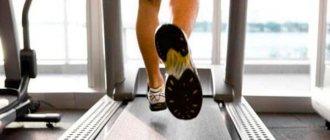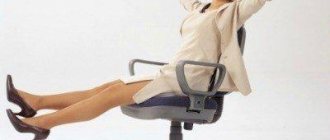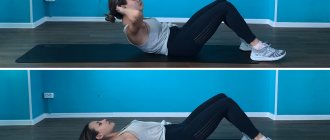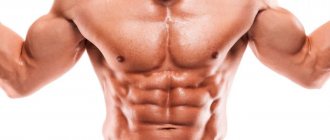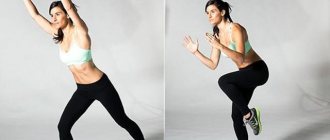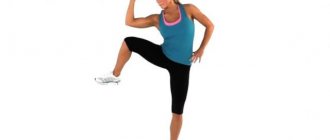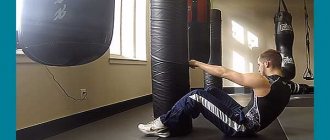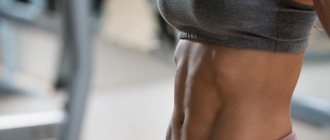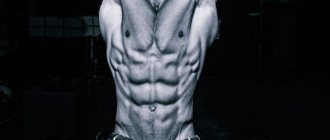A strong and firm press is not only a beautiful toned stomach, but also a guarantee of healthy musculoskeletal system. A pumped muscle corset (core) has a beneficial effect on the spine, pelvis and legs. Regularly performing abdominal exercises helps prevent back diseases caused by weak core muscles.
We offer you 30 effective abdominal exercises + 3 training options that can be alternated. The presented program is suitable for both beginners and experienced students.
Where and how to pump up the press
At home
The core muscles recover the fastest, so you can work out your abs at home every day as a light warm-up in the morning or as one of your home workouts. The main advantage of working out on the abs at home: you only need a mat. The result can be obtained even without additional equipment. But, if you do not feel a burning sensation in your muscles, it is better to purchase fitness bands, dumbbells or weights.
In the hall, on the horizontal bar and uneven bars
In good weather, you can go out to the playground and swing on the horizontal bar, or in the gym - on the uneven bars. When working on parallel bars, not only the abdominal muscles are strengthened, but also neighboring muscle groups: back, chest, shoulders.
shutterstock.com
In the gym, you can increase your strength and use equipment (dumbbells, weights, fitness bands) in the same exercises that you do at home. Sports equipment loads the target muscle more and more effectively.
The most effective exercises for the abs: how to pump them up at home
Hanging Leg Raise
This exercise is the most effective for pumping up abs both in the gym or on the street, and at home. There are different variations of its implementation - each of them is effective. An exercise is one whose difficulty is proportional to its effectiveness. The entire abs are engaged, with the lower part being most tense. However, the division of the press into upper and lower is conditional.
Forward crunches
In order to pump up a man’s abs from scratch, it is necessary to pay attention to simple lifts of the torso, since when performing this exercise, the upper parts of the abdomen are perfectly worked out. It can be performed either sitting on a bench or on the floor (using only your own weight, without weights). You can use a simulator, which will allow you to regulate the load, increasing it by 20-30% of your weight.
Static voltage
Statics is performed in many variations, including exercises with a fitball (large soft ball) and other equipment that allows you to provide unstable support so that you have to maintain balance on it. Only balance and statics allow you to create a load that can engage the deep abdominal muscles.
You can pump up your abs, like any other muscles, only with high-quality recovery - this is the only way your abs can grow quickly and effectively, even at home. Therefore, it is necessary to take two to three day breaks between classes.
In order to pump up the abdominal muscles, the intensity of the load is extremely important for both men and women. This means that the total number of movements performed is not as important as how intensely you work for a short period of time (5-10 minutes).
Features for girls
Cubes and pronounced abs are the result of not only training, but also proper nutrition and recovery. Beautiful abs are visible with a small percentage of body fat: approximately 18-20% for girls.
Strong abdominal muscles not only form beautiful posture, but also help cope with pain during pregnancy: with strong muscles, this period is easier to bear. Also, good press affects a stable female cycle and other features of the female body.
shutterstock.com
When working on the abs, heavy weights are not recommended: focus on working with breathing. You should not exercise your oblique abdominal muscles with dumbbells: your waist may visually increase. Choose exercises from Pilates or functional training.
Abdominal training (option No. 1)
The complex includes exercises with an emphasis on each group of abdominal muscles: upper, middle and lower abs, lateral muscles, deep muscles. The entire muscle corset is evenly strengthened. Choose a training plan that is convenient for you (by time or repetition) and complete the proposed programs on a regular basis.
Abs training by number of repetitions:
- Crunch with knee lift : 15-20 reps.
- Straight leg cross touches : 10-15 reps on each side.
- Forearm bicycle : 10-15 reps on each side.
- Leg tuck : 15-20 reps.
- Plank to all fours steps (right side) : 10-15 reps.
- Plank to all fours steps (left side) : 10-15 reps.
- Floor rolls : 15-20 reps.
- Oblique palm-foot crunches (right side) : 15-20 reps.
- Oblique palm-foot crunches (left side) : 15-20 repetitions.
- Vertical scissors with hands : 15-20 repetitions on each side.
- Bicycle with a raised body : 10-15 repetitions on each side.
- Elbow plank body rotations : 10-15 reps on each side.
Abs training by time:
- For entry level. Exercise scheme: 30 seconds of work, 15 seconds of rest. The total training time will be 9 minutes. You can repeat the exercises in two circles, in which case the training time will be 19 minutes. Rest between circles for 1 minute.
- For advanced level. Exercise scheme: 45 seconds of work, 15 seconds of rest. The total training time will be 12 minutes. You can repeat the exercises in two circles, in which case the training time will be 25 minutes. Rest between circles for 1 minute.
You can alternate between the three workout plans, ideally taking a day off between workouts. For example:
- Monday: plan option No. 1
- Wednesday: plan option No. 2
- Friday: plan option No. 3
Crunch with knee lift
Benefit of the exercise: Enhanced development of the upper abdominal area. The rectus muscle, the lower third of the abdomen, is also involved in lifting, since you need to support the weight of your legs. The relief improves and the volume of the cubes increases noticeably.
How to do it: Lie on the mat, place your hands under your head, spread your elbows to the sides. Bend your legs and bring your thighs perpendicular to the floor. Set your knees to a right angle. Lift your head and upper shoulder girdle off the floor, tighten your abs. Press your lower back tightly, do not bend your neck.
How to simplify: Lower your knees to the floor, you can cross your arms over your chest.
How much to perform: 15-20 repetitions.
Straight leg cross touches
Benefits of the exercise: Strengthening the oblique, intercostal and serratus muscles. When lifting the body, the upper abdomen is engaged, the lower region is loaded due to holding the legs in the air. On the sides the muscles become more prominent.
How to do it: Lie on your back, straighten your legs straight up. Raise your shoulders with your head and shoulder blades, and place your hands on the back of your head. Twist to the right and straighten your left arm, touching your right leg at the ankle. Lower yourself and repeat on the other side. Perform the exercise alternately on both sides.
How to make it easier: Bend your knees until your shins are parallel to the floor or place your straight legs against the wall.
How much to do: 10-15 repetitions on each side.
Bicycle on forearms
Benefit of the exercise: Pumping the lower abdomen. The rectus abdominis muscle is loaded no less. The muscles of the legs work. Improves core tone and posture. This is a simple but effective abdominal exercise.
How to do it: Sit on the mat, lower your torso back, placing your hands on your elbows and pointing your forearms towards your pelvis. Lift your legs and pull them to your torso, as if you were spinning a bicycle. Look forward, do not tilt your head forward too much. Straighten your legs one at a time. Do not touch the floor with your heels.
How to simplify: The exercise is not difficult, but you can raise your legs higher above the floor.
How much to do: 10-15 repetitions on each side.
Fold with leg lift
Benefit of the exercise: Pumping the rectus abdominis muscle. Works the upper and lower abs with the same intensity. Indirectly, the load is distributed over oblique beams. This abdominal exercise also strengthens your back.
How to do it: Sit on the floor, tilt your body back a little, spread your arms to the sides, keep your abs tense. Stretch your legs, keep them suspended. At the same time, pull your hips toward your body and fold your arms to cup your shins. Don't slouch, keep your neck, head and back in line.
How to simplify: You can lower your legs to the floor, rather than keeping them suspended. Another simplification option is to place your hands under your buttocks.
How much to perform: 15-20 repetitions.
Steps from plank to all fours
Benefits of the exercise: Pumping every abdominal muscle, especially the lower abs. The hips, buttocks, and back are additionally strengthened. Stabilizers are being developed. The tone returns to the whole body.
How to do it: Take a classic plank position - straighten your legs and arms, establish a single line in your spine. Step forward with your right foot so that your thigh is perpendicular to the floor, then step forward with your left. Do not change the position of the body throughout. Stand back up, stepping first with your right foot, then with your left. First perform a whole approach on one leg, then on the other (in the first approach, the right leg steps first, in the second approach, the left leg steps first).
How to make it easier: While on all fours, lower your knees to the floor for a couple of seconds to rest your muscles.
How much to do: 10-15 repetitions first on one side, then 10-15 repetitions on the other side.
Rolls on the floor
Benefits of the exercise: Strengthening the rectus and transverse abdominal muscles, oblique bundles. The load is emphasized on the bottom. The lower back is massaged. This abdominal exercise also improves your sense of balance.
How to do it: Lie on your back, press your head, shoulders and back firmly to the floor, stretch your arms along your body. Bend your legs, place them on your heels. To twist, tighten your abs, pull your hips up to your chest, lifting your lower back and pelvis. Do not tear off your head, shoulder blades, shoulders and arms.
How to make it easier: Place your hands under your buttocks. Reduce the amplitude - do not lift your back from the floor, only your lower back and buttocks.
How much to perform: 15-20 repetitions.
Oblique palm-foot crunches
Benefit of the exercise: Strengthened training of each part of the abs - bottom, top and oblique beams. Posture improves, straightens, and strengthens your back. The figure is tightened, imperfections are corrected.
How to do it: Lie on the mat, straighten your legs and spread your arms to the sides, place them on the floor. Press your back – from your shoulder blades to your buttocks. Raise your left arm with your right leg, touching at the top. Tear off only the shoulder blade and shoulder. Leave your other arm and leg on the floor. Perform the entire set on one side.
How to simplify: Raise your leg bent at the knee. Touch your knee, not your foot.
How much to do: 15-20 repetitions first on one side, then 15-20 repetitions on the other side.
Vertical scissors with hands
Benefit of the exercise: Accented pumping of the lower abdominal area. The rectus muscle and oblique bundles work less intensely. The load goes on the buttocks and hips, popliteal ligaments, back, deltoids.
How to do it: Lie on your back, straighten up, and place your arms along your body. Lift your head and shoulders slightly off the floor, keep your legs straight and suspended. Alternately raise and lower your legs at medium amplitude. Press your back firmly into the floor. Use your hands to repeat the movements of the scissors.
How to simplify: Raise your legs higher above the floor, you can put your hands under your buttocks.
How much to perform: 15-20 repetitions on each side.
Bicycle with raised body
Benefits of the exercise: Development of the rectus, internal and external oblique muscles. Fat burning is enhanced and blood flow to the legs is activated. One of the best abdominal exercises, it is considered a functional movement involving multiple muscles.
How to do it: Sit on the mat, stay on your buttocks and tuck your hips, keeping your knees at a 90-degree angle. Tilt your body back and clasp your hands behind your head. You will get a simplified fold. Do twists to the right and left, touching your opposite knees with your elbows. Bend your legs, straighten them.
How to make it easier: Lower the foot of the extended leg to the floor.
How much to do: 10-15 repetitions on each side.
Torso rotations in elbow plank
Benefits of the exercise: Working on the abs, especially the oblique muscles. The back and buttocks are actively working, stabilizers and hip joints are activated. A difficult but extremely effective movement.
How to do it: Take a plank position on your elbows - there is one line in the spine, knees straight, stomach tucked, feet apart shoulder-width apart. Then twist your body to the right along with your hips and buttocks, bring your pelvis to the floor, but do not touch it. Come back and repeat to the left side.
How to simplify: Turn your pelvis slightly to the side, with a small amplitude.
How much to do: 10-15 repetitions on each side.
If desired, you can repeat the exercises in two circles.
We also recommend watching:
- Top 10 Ab Exercises for Beginners
- Top 10 abdominal exercises for advanced
Features for men
Guys can lift more weight, use kettlebells and heavy dumbbells. Men tend to have stronger muscles in their arms, back and chest, meaning more complex exercise options are available to them.
shutterstock.com
All muscles in the body are inextricably linked with each other. Even if you train your legs, the abdominal muscles are involved in the work, which form a muscle corset. There are individual characteristics of the body, for example, hyperlordosis - excessive lumbar deflection or various clamps in the cervical and lumbar region, which require a more specialized approach. In this case, you need to contact a trainer and switch to the personal training format: the instructor will conduct a visual diagnosis of the body and minimize the risk of injury.
View this post on Instagram
A post shared by REBOOT interval training (@reboot.ru)
Circle 3
Raising the body with straightening the arms
The exercise is performed slowly for four counts:
- Raise your body, keeping your arms crossed behind your head. The lower back is pressed to the floor.
- From this position, straighten your arms in front of you. We stay in this position for a second.
- We return our hands to our heads.
- We lower the body onto the mat.
We do the exercise for 30 seconds.
"Ladder"
Technique:
- We lie on the mat. Legs are bent, hands are under the buttocks;
- we raise both legs up, they are still bent at the knees;
- lower first the right and then the left leg down;
- We perform each movement slowly. Do not lift your lower back off the floor.
We do the exercise for 30 seconds.
Photo: istockphoto.com
Basic rules for abdominal training
When performing abdominal exercises for beginners, remember several important features:
- By pumping your abs in isolation, you can achieve a clear definition only if the thickness of the fold of fat is no more than 2-3 cm. If you need to get rid of excess weight, use the exercises described above in conjunction with aerobic and strength training.
- When working on your relief or abdominal strength, never forget about the quality of your own diet and drink. Good and healthy food will not be deposited in the form of folds on the stomach. Drinking plenty of fluids (pure water, tea/coffee without sugar, low-concentrated juices) improves metabolism and prevents excess fat from accumulating under the skin. Simple twists and leg lifts will not remove fat folds. Check out our article on healthy eating.
- Many abdominal exercises activate other muscles of the body (hamstrings, quadriceps, back, neck). Your task is to constantly monitor the tension of the abdominal muscles in order to effectively work them. Otherwise, you risk doing useless work. Be focused, attentive and consistent when training your abdominal muscles.
- Don't forget about the internal abdominal muscles. The “vacuum” exercise is the best for working them out. Its essence lies in strongly drawing in the abdomen and fixing the position for several seconds. “Vacuum” is actively used in yoga, fitness, and bodybuilding.
- Strong abdominal muscles help support your core during other exercises, reducing stress on your spine. Strong abs are especially important for bodybuilders and weightlifters. To prevent your muscles from having time to adapt to the same type of exercise, change your training program every 7 weeks.
- If you do the basics in the gym (deadlifts, squats), then you should not additionally load your abs these days. It already works great under high loads.
- It is better for beginners to perform abdominal exercises after a preliminary warm-up (warm-up exercises). This will bring the body into combat readiness and achieve maximum results when pumping the abdominal muscles.
- At the end of the workout, we recommend performing a relaxing set of exercises for the back.
This is the main list of features that need to be taken into account when performing abdominal exercises for beginners. With experience, you will notice more individual characteristics that will help you train more effectively and achieve outstanding results.
Timer 30 seconds work / 15 seconds rest
If you don’t like to count the number of repetitions, then perform the presented abdominal exercises according to the following interval scheme: 30 seconds work / 15 seconds rest. In this case, the workout will take you 7 minutes if you repeat the exercises in one circle, or 15 minutes if you repeat the exercises in two circles.
LINK TO TIMER.
Exercise "Twisting"
The exercise is magical if done correctly. We lie down, press our lower back tightly, lift off our upper body and begin twisting. It is very important to breathe correctly, we exhale with effort, we pull our chin to the sky, our movement occurs due to the press, and not due to the neck, we do not help. It is better to do this exercise more slowly.
Complex for 8 minutes
This 8-minute complex is simpler than the previous one, as it consists of less strenuous exercises. It should take you about 8 minutes, and you can train 3-4 times a week, even at home:
- Twisting. Lie down on the floor, bend your legs at the knees, fold your arms behind your head or cross them over your chest (the second option is easier) and begin to twist, lifting your shoulder blades off the floor. To avoid injury to your lower back, do not lift it off the floor.
- Side crunches. The exercise is similar to the previous one, but in it, when twisting the torso, you need to turn it to the sides. Try to touch your left elbow to your right knee, and vice versa. Work slowly, achieving a burning sensation.
- Crunches with legs extended. Lying on your back, lift your straightened legs and arms up. Start twisting, lifting your shoulder blades off the floor and trying to reach your feet with your hands.
- Leg raises. Lying on your back, spread your arms and place them on the floor to maintain balance. Begin to lift your straightened legs up and smoothly lower them back, but not until they touch the ground.
- Plank. Take a lying position and fix your body, stretching your spine in one line. Try to stand like this for at least 1 minute.
Exercise "Corner"
We will straighten our legs and stay in this position. The main thing is to keep it at 90 degrees, a right angle. We look straight ahead, breathe. The muscles have already worked, and we are just finishing them off with this exercise.
This exercise is not for beginners, and it is difficult. If it’s difficult for you, you can lower your legs a little or bend them a little. If you can't do it at all, you can just do a plank instead.
We spent five minutes and made one circle. Make two more. As you can see, this set of exercises for pumping up the abs is very simple, takes only 15 minutes, and women really like to do it.
80% of success depends on nutrition
The statement is true if you need a press with a clearly defined relief. In fact, everyone has abdominal muscles. They develop under a layer of fatty deposits and perform the function of stabilizing body position.
Anyone who adheres to a calorie deficit can create relief. Muscles are hidden under a layer of fat, and to achieve six-pack, you need to lose weight. To do this, you need to calculate the daily calorie intake and subtract 10-15% percent - create a deficit.
The diet is built individually and in accordance with the calculation of the kbzhu. After two to four weeks, the first noticeable result will appear. The menu should consist of natural products. What is best avoided is:
- ready-made store food;
- sauces;
- fast food;
- baking;
- sweets.
To achieve results faster, you need to take your diet seriously. Do not consume foods whose composition and calorie content are unknown. You need to add more protein to your diet and reduce the amount of fat.
With regular workouts and disciplined, mindful eating, the appearance of six-pack abs is as inevitable as the sun rising!
